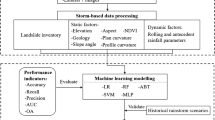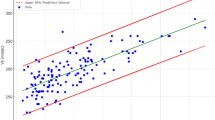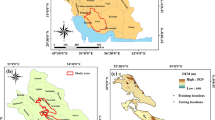Abstract
Mining induced land subsidence is one of the most hazardous geological phenomenon. Predictive modeling of the ground subsidence has attracted increased interest and is crucial to the hazard prevention. In this research, a data-driven approach integrated with survival analysis to model the mining-induced subsidence is studied. The data used in this research is collected in Fuxin, Liaoning Province, China and it contains multiple variables from different subsided locations. First, a survival analysis is conducted using the Cox proportional hazard model to evaluate the importance of variables considered. p values of all variables are computed and the important variables are selected. Next, data-driven models including k-nearest neighbor, support vector machine, back-propagated neural network, random forest, extreme learning machine, and online sequential extreme learning machine are constructed to predict the subsidence values and horizontal movement. Two evaluation matrices namely MAPE and RMSE are introduced to evaluate the performances of the data-driven models. Computational results demonstrate that online sequential extreme learning machine is capable of accurately predict the mining induced subsidence and surface deformation.



Similar content being viewed by others
References
Agioutantis ZG, Karmis M (2013) Recent developments on surface ground strain calculations due to underground mining in Appalachia. In: Proceedings of 32nd international conference on ground control in mining, Morgantown, West Virginia, pp. 214–219
Allison PD (2014) Event history and survival analysis: regression for longitudinal event data, vol 46. SAGE Publications, Beverley Hills
Ambrožič T, Turk G (2003) Prediction of subsidence due to underground mining by artificial neural networks. Comput Geosci 29(5):627–637
Choi JK, Kim KD, Lee S, Won JS (2010) Application of a fuzzy operator to susceptibility estimations of coal mine subsidence in Taebaek City, Korea. Environ Earth Sci 59(5):1009–1022
Cox DR, Oakes D (1984) Analysis of survival data, vol 21. CRC Press, Boca Raton
Deng C, Huang G, Xu J, Tang J (2015) Extreme learning machines: new trends and applications. Sci China Inf Sci 58(2):1–16
Díaz-Uriarte R, De Andres SA (2006) Gene selection and classification of microarray data using random forest. BMC Bioinform 7(1):3
Esaki T, Djamaluddin I, Mitani Y (2008) A GIS-based prediction method to evaluate subsidence-induced damage from coal mining beneath a reservoir, Kyushu, Japan. Q J Eng Geol Hydrogeol 41(3):381–392
He Y, Kusiak A (2018) Performance assessment of wind turbines: data-derived quantitative metrics. IEEE Trans Sustain Energy 9(1):65–73
He Y, Deng J, Li H (2017a) Short-term power load forecasting with deep belief network and copula models. In: 2017 9th International conference on intelligent human-machine systems and cybernetics (IHMSC), vol 1, pp. 191–194
He Y, Kusiak A, Ouyang T, Teng W (2017b) Data-driven modeling of truck engine exhaust valve failures: a case study. J Mech Sci Technol 31(6):2747–2757
Huang GB, Zhu QY, Siew CK (2006) Extreme learning machine: theory and applications. Neurocomputing 70(1–3):489–501
Huang M, Lin R, Huang S, Xing T (2017) A novel approach for precipitation forecast via improved K-nearest neighbor algorithm. Adv Eng Inform 33:89–95
Keilich W, Seedsman RW, Aziz N (2006) Numerical modelling of mining induced subsidence. http://ro.uow.edu.au/coal/58/
Kim KD, Lee S, Oh HJ, Choi JK, Won JS (2006) Assessment of ground subsidence hazard near an abandoned underground coal mine using GIS. Environ Geol 50(8):1183–1191
Lee S, Park I (2013) Application of decision tree model for the ground subsidence hazard mapping near abandoned underground coal mines. J Environ Manag 127:166–176
Li H, Feng W, Xu Q, He Y, Luo B, Chen S (2017) A revised formula to compute shear strength of unsaturated soils. Int J Georesour Environ IJGE Former Int’l J Geohazards Environ 3(1-2):47–55
Li P, Wang X, Cao W, Zhang D, Qin D, Wang H (2018) Influence of spatial relationships between key strata on the height of mining-induced fracture zone: a case study of thick coal seam mining. Energies 11(1):102
Liang NY, Huang GB, Saratchandran P, Sundararajan N (2006) A fast and accurate online sequential learning algorithm for feedforward networks. IEEE Trans Neural Netw 17(6):1411–1423
Lin DY, Wei LJ (1989) The robust inference for the Cox proportional hazards model. J Am Stat Assoc 84(408):1074–1078
Lu B, Cai D, Wang L, Tong X, Xiang H (2018) Inference for proportional hazard model with propensity score. Commun Stat Theory Methods 1–11. https://doi.org/10.1080/03610926.2017.1343849
Luo Y, Qiu B (2012) Enhanced subsurface subsidence. Min Eng 64(10):78–84
Mao W, He L, Yan Y, Wang J (2017) Online sequential prediction of bearings imbalanced fault diagnosis by extreme learning machine. Mech Syst Signal Process 83:450–473
O’connor KM, Dowding CH (1992) Distinct element modeling and analysis of mining-induced subsidence. Rock Mech Rock Eng 25(1):1–24
Oh HJ, Lee S (2010) Assessment of ground subsidence using GIS and the weights-of-evidence model. Eng Geol 115(1–2):36–48
Ouyang T, He Y, Li H, Sun Z, Baek S (2017a) A deep learning framework for short-term power load forecasting. arXiv preprint arXiv:1711.11519
Ouyang T, Kusiak A, He Y (2017b) Modeling wind-turbine power curve: a data partitioning and mining approach. Renew Energy 102:1–8
Ouyang T, Kusiak A, He Y (2017c) Predictive model of yaw error in a wind turbine. Energy 123:119–130
Peng D, Xu Q, Liu F, He Y, Zhang S, Qi X, Zhang X (2017) Distribution and failure modes of the landslides in Heitai terrace. China. Eng Geol 236:97–110
Reddish DJ, Whittaker BN (2012) Subsidence: occurrence, prediction and control, vol 56. Elsevier, Amsterdam
Ren G, Li G, Kulessa M (2014) Application of a generalised influence function method for subsidence prediction in multi-seam longwall extraction. Geotech Geol Eng 32(4):1123–1131
Seedsman R, Pells PJN (2014) On the deception in requiring and providing singular accurate predictions for surface subsidence, tilt and strain. In: Proceedings of the 9th triennial conference on mine subsidence, p. 63
Su H, Cai Y, Du Q (2017) Firefly-algorithm-inspired framework with band selection and extreme learning machine for hyperspectral image classification. IEEE J Sel Top Appl Earth Obs Remote Sens 10(1):309–320
Sun Z, He Y, Gritsenko A, Lendasse A, Baek S (2017) Deep spectral descriptors: learning the point-wise correspondence metric via Siamese deep neural networks. arXiv preprint arXiv:1710.06368
Suykens JA, Vandewalle J (1999) Least squares support vector machine classifiers. Neural Process Lett 9(3):293–300
Xu Q, Li H, He Y, Liu F, Peng D (2017) Comparison of data-driven models of loess landslide runout distance estimation. Bull Eng Geol Environ 1–14. https://doi.org/10.1007/s10064-017-1176-3
Zahiri H, Palamara DR, Flentje P, Brassington GM, Baafi E (2006) A GIS-based weights-of-evidence model for mapping cliff instabilities associated with mine subsidence. Environ Geol 51(3):377–386
Author information
Authors and Affiliations
Corresponding author
Rights and permissions
About this article
Cite this article
Wei, Y., Yang, C. Predictive Modeling of Mining Induced Ground Subsidence with Survival Analysis and Online Sequential Extreme Learning Machine. Geotech Geol Eng 36, 3573–3581 (2018). https://doi.org/10.1007/s10706-018-0558-z
Received:
Accepted:
Published:
Issue Date:
DOI: https://doi.org/10.1007/s10706-018-0558-z




